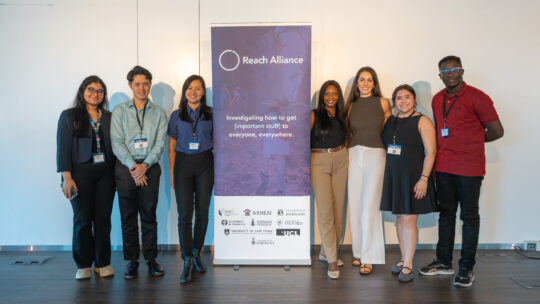For the past year, the Reach Thailand team has immersed itself in the depths of academic literature on Thailand’s healthcare system, from international reports to available data sets that illustrate the remarkable success story of Thailand’s elimination of mother-to-child transmission of HIV. And there is a lot out there.
What emerged was the mammoth-like prowess of Thailand’s comprehensive health infrastructure that is the foundation upon which the national prevention of mother-to-child-transmission of HIV (PMTCT) program was built. Consider one facet of this success: the rates of HIV counseling and testing increased from 63% in 1998, to over 92% in just one year after the introduction of the PMTCT program.
How exactly was Thailand, a country divided into 12 regions and 77 provinces, able to turn this policy into practice with such swiftness, consistency and rigor?
Since arriving in Thailand last Sunday, we have spent the week meeting with key stakeholders, from policy makers to frontline workers, to dig into this question.
There was just one fork in the winding road of “reach”: our knowledge of the literature did not lend itself to a holistic understanding of the informal networks and personal relationships underlying Thailand’s success story. So, after four full days of interviews, we took an early morning road trip to a district hospital in Phrao, a rural community in the Northern region of Thailand. What followed was a visceral experience of the ingredients that have allowed Thailand to reach.
As we stepped into the Phrao hospital, it became clear that our understanding of maternal health services was incomplete. For example, there was very little distinction between the antiretroviral (ARV) and antenatal care (ANC) clinics, as both were intertwined. Our guide, a peer educator and a leader within the Network of Thai Women with HIV, was bright-eyed and eager to show us her place of work with pride.
Although we expected a brief interview and a quick view of the hospital – an open, colorful space with several patients for the day’s appointments – she accompanied us to nearly all the clinical areas for brief chats with each type of healthcare provider. It felt like a buffet of sorts: meeting a medical technician in the lab, observing the ARV and ANC area, going into the delivery and recovery rooms, venturing into the pharmacy to see both donated and stocked HIV medications, and even the psychiatric unit where women with post-partum depression and other conditions can receive support.
While we received an abundance of information about the intricacies of MTCT service provision, this was only a portion of the insight we gained. All of the MTCTguidelines we had read about suddenly had a human face to them – and they functioned remarkably well. We quickly realized what we had missed: the quality of care was textured by a camaraderie and respect that informed a cohesive network of relationships amongst all healthcare personnel, including village health volunteers, nurses, pharmacists, and peer educators. Even the director of the hospital took a moment to inform us about a new case in the hospital: a woman with HIV had just delivered and, as per the PMTCT policy, was feeding the newborn baby formula with her husband at her side.
Ultimately, norms of peer-to-peer and community-level inclusivity seemed to be an underlying scaffold for why PMTCT policy was implemented so outstandingly well. While there is variation at the local level in certain services such as counselling, our site visit showed us that local context shapes how these peer educators and other healthcare personnel work together. For instance, the Phrao peer educator mails out ARVs to HIV-positive mothers who live far away in the mountains of Northern Thailand or fear of coming to the hospital due to stigma. As the Phrao peer educator told us, peer educators are not just “victims” or people with HIV, they are service providers themselves.
An impressive level of trust not only exists between the healthcare providers in the front lines, but also between the local service providers and national policy makers. Our peer educator guide is often invited to national government meetings to represent the community and speak to the needs of people living with HIV.
The Phrao district hospital painted a picture of Thailand’s PMTCT story in many colours. Multi-directional networks that operate through both informal and formal means have been established over time between people living with HIV, healthcare providers, bureaucrats, policy makers, and NGOs. Central to the success of the healthcare infrastructure is trust, respect, and accountability amongst all.
Most importantly, the role of peer educators has become cemented in the delivery of PMTCT, and even the overall HIV/AIDS response. Thai society has collectively realized the immense value of their role in all levels of healthcare. So, it was to our delight when we were informed that the government of Thailand has begun funding the work of Peer Educators this year!
By The Thailand Research Team
